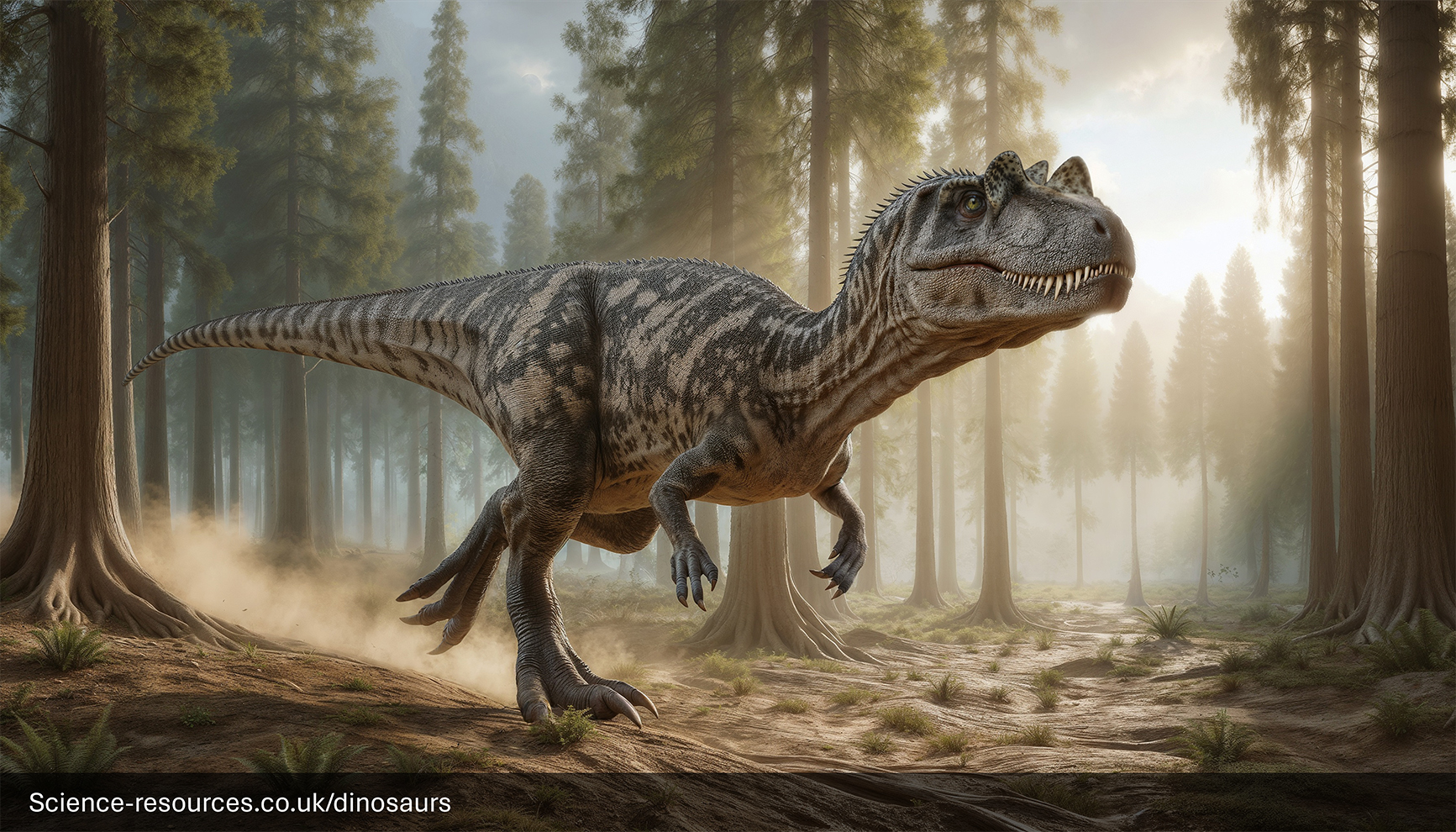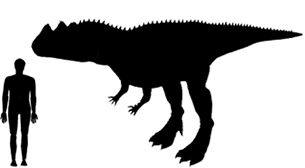Dinosaurs A:Z | C
You may also be intrested in: Free Dinosaur games
Dinosaurs: Ceratosaurus (Horned Lizard)
You may also be intrested in: Free Dinosaur games
Last updated: 9th Sep 2024 Ceratosaurus, pronounced SER-a-toe-SAW-rus, meaning "horned lizard" was a medium-sized, meat-eating dinosaur that lived during the Late Jurassic period (approximately 153 to 148 million years ago). It was a remarkable predator known for its distinctive horns and body armor. • Length: Ceratosaurus could grow up to 6 to 7 meters (20 to 23 feet) long. • Weight: It weighed around 1,000 kilograms (about 1 ton), similar to a small car. Ceratosaurus had several unique and interesting features: • Horns: It had a large horn on its nose and two smaller horns above its eyes. • Teeth: Ceratosaurus had very long, slender teeth in its upper jaw, which could be over 9 centimeters long. • Arms: It had short arms with four-fingered hands and sharp claws. • Legs: Ceratosaurus walked on two powerful hind legs, making it a fast and agile predator. • Body Armor: A row of bony plates ran along its back, possibly for protection.
Generative AI Notification: Some elements of this image have been created or enhanced using AI technology. To find out how we create all our dinosaurs, click here. Ceratosaurus was a carnivore, meaning it ate meat. Its prey likely included plant-eating dinosaurs such as Stegosaurus and possibly aquatic animals like fish, turtles, and crocodiles. Its long teeth were perfect for inflicting deep, slashing wounds in its prey. Ceratosaurus may have hunted in packs, choosing to target young or sick plant eating dinosaurs. Fossils of Ceratosaurus have been found in North America and Portugal. During the Late Jurassic period, these regions were rich in diverse plant and animal life, providing plenty of food for this formidable predator. • Meaning: Ceratosaurus means "horned lizard." • Family: Ceratosaurus belonged to a group of dinosaurs called Ceratosaurs, which included other species like Dilophosaurus and Coelophysis. • Hunting: It may have hunted in packs, targeting young or sick dinosaurs. • Rare: Ceratosaurus fossils are much rarer than those of Allosaurus, another predator from the same period.
What is Ceratosaurus?
How big was Ceratosaurus?
Appearance
 Ceratosaurus
CeratosaurusWhat did Ceratosaurus eat?
Where did Ceratosaurus live?
Interesting facts
Pronounced: SER-a-toe-SAW-rus


Ceratosaurus Facts
Name Means: "Horned Lizard"
Length: 20 - 23 feet (6 - 7 m)
Height: 8 feet (2.5 m)
Weight: 1 ton (1,000 kg)
Diet: Carnivore (Meat)
Time: Late Jurassic - 150 million years ago
Habitat: Open
Countryside
Fossils Found: Europe, North America
Ceratosaurus belonged to the family Ceratosauridae. This family of dinosaurs is known for their distinctive features, including a prominent horn on their snout and a pair of horns above their eyes. Ceratosaurus was a biped, meaning it walked on two legs. Its strong legs made it well-suited for chasing down prey and moving quickly through its environment. The large horn on its nose and the smaller horns above its eyes might have been used for display, to attract mates, or to intimidate rivals and predators. The purpose of its bony armor is still a mystery, but it could have offered protection during fights. Ceratosaurus had several unique features that set it apart from other dinosaurs: • Long teeth: Its upper jaw had long, slender teeth perfect for slashing prey. • Horns and Armor: The large nasal horn and bony armor along its back were distinctive traits. • Primitive hands: Its four-fingered hands were more primitive compared to other theropods. Q1: What is a Ceratosaurus? A1: Ceratosaurus was a medium-sized, carnivorous dinosaur that lived during the Late Jurassic Period, around 153-148 million years ago. Its name means "horned lizard" because of the distinctive horn on its snout. Q2: How big was the Ceratosaurus? A2: Ceratosaurus could grow up to 23 feet long and weigh around 1 ton. It had a deep, robust body, strong legs, and a long tail. Q3: What did Ceratosaurus eat? A3: Ceratosaurus was a carnivore, meaning it ate meat. It likely preyed on smaller dinosaurs, fish, and other animals, using its sharp teeth and claws to catch and eat its prey. Q4: Where did Ceratosaurus live? A4: Ceratosaurus lived in what is now North America and possibly parts of Europe and Africa. Fossils have been found in the Morrison Formation in the United States and the Lourinhã Formation in Portugal. Q5: What makes Ceratosaurus different from other dinosaurs? A5: Ceratosaurus is known for its distinctive horn on its snout and a pair of smaller horns above its eyes. It also had a row of small osteoderms (bony plates) along its back. Q6: How did Ceratosaurus hunt its prey? A6: Ceratosaurus likely used its speed and agility to chase down prey. It may have also used ambush tactics, hiding and then quickly attacking its prey with its sharp teeth and claws. Q7: What did Ceratosaurus look like? A7: Ceratosaurus had a deep, robust body, strong legs, and a long tail. It had a distinctive horn on its snout, smaller horns above its eyes, and a row of small osteoderms along its back. Q8: Why is Ceratosaurus important to scientists? A8: Ceratosaurus provides valuable insights into the evolution of theropod dinosaurs and their adaptations. Its fossils help scientists understand dinosaur behaviour, anatomy, and the environment of the Late Jurassic. Q9: Where can I see a Ceratosaurus skeleton? A9: You can see Ceratosaurus skeletons in several museums, including the Natural History Museum of Utah and the Smithsonian's National Museum of Natural History. Q10: What is the significance of the name Ceratosaurus? A10: The name Ceratosaurus means "horned lizard," reflecting its distinctive horn on its snout. It was named by paleontologist Othniel Charles Marsh in 1884. Which family did Ceratosaurus belong to?
How did Ceratosaurus move?
Why did Ceratosaurus have horns?
Unique features of Ceratosaurus
Ceratosaurus FAQ
You may also be intrested in:
Tags: How big was Ceratosaurus, Ceratosaurus size, where does Ceratosaurus live, how tall are Ceratosaurus, what does Ceratosaurus mean, Ceratosaurus, Ceratosaurus facts